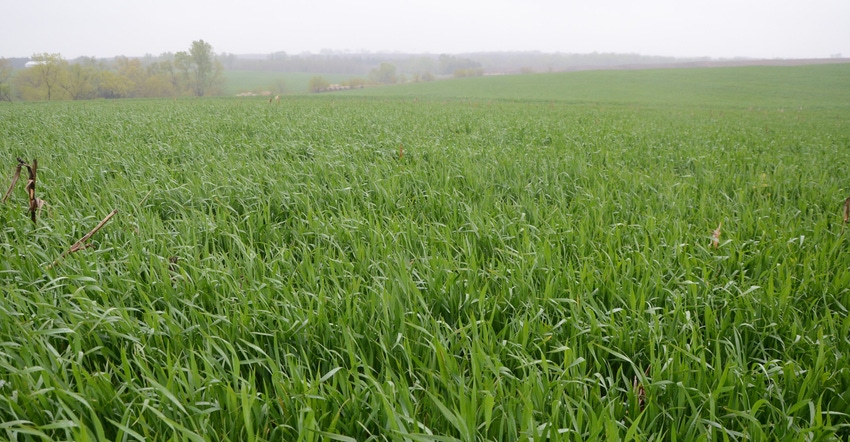May 5, 2017

Over the last several years, the term "planting green" has come to prominence in cover crop and no-till circles. The practice refers to planting a cash crop into a standing cover crop — typically cereal rye — and terminating the cover crop after planting.
Of course, late termination of cover crops and planting green come with some different management considerations. "You're managing not only the soybean and corn crop, but termination of that cover crop," notes Keith Glewen, Nebraska Extension educator. "You add to that the thousands of acres that some growers are covering, and that adds to the complexity factor."
Planting green most often refers to planting soybeans into a standing rye cover crop following corn.
However, there are advantages, notes Dan Gillespie, a no-till specialist with the Natural Resources Conservation Service and a farmer near Battle Creek. "We have a way to extend the time we can grow cover crops by overlapping that with the initial stages of cash crop growth," says Gillespie, who has planted green on his farm off and on for five years, depending on rainfall in a given year.
This means more time to produce more biomass, and that means greater suppression of winter annual weeds and early-season weeds like kochia. For cattle producers, it also means more biomass for grazing.
Water use a factor
For cereal rye, it also means more water use, which can be a pro or a con, depending on location.
In eastern Nebraska and states farther east, removing excess water can “de-water” fields and allow growers to get in the field and plant in a timely manner.
This also can be a downside, especially when cereal rye flowers, notes Rodrigo Werle, Extension cropping systems specialist at the West Central Research and Extension Center in North Platte. "At that point, it's going to start investing in grain production, and we don't want any grain out of the cereal rye," Werle says. "It's going to use more water, and you're not getting a return anymore because the biomass production isn't going to increase."
Another consideration is federal crop insurance. The Risk Management Agency requires growers to terminate by the time the cash crop is planted in eastern Nebraska and the rest of the Corn Belt, and 15 days before planting in central and western Nebraska for dryland cropping systems. For irrigated cropping systems, cover crops should be terminated before crop emergence.
Get more INSIGHT: Download Cover Crops: Best Management Practices now!
Where crop insurance isn't an issue, Gillespie encourages growers to terminate based on how much moisture is available in the soil. "If you've got GMO corn or soybeans and can terminate with glyphosate at any point in time, it's just a matter of how much moisture you're getting," he says. "Can you get into the field? If it's too wet to get in the field, the rye isn't using moisture your cash crop needs anyway. It's a reaction to what Mother Nature gives you."
Benefits of living roots
However, over the long-term, later termination and planting green can result in more water-holding capacity. Later termination also means more biomass, which equates to higher organic matter. Gillespie notes at the boot stage, cereal rye can have a root system 42 inches deep. Although this doesn't immediately translate into recalcitrant organic matter, it does increase the amount of active organic matter that cycles in the growing season. Over time, this means more water-holding capacity.
"With an extra percent of organic matter, you can harvest three-quarters of an inch of more soil moisture. This can happen repeatedly through the year, it's not just a one-time thing," Gillespie says.
Meanwhile, growers are planting into a seedbed that already has a living mycorrhizal fungi system in it — what Gillespie calls the "myco-bridge." According to Gillespie, this has a number of possible benefits, including suppressing pathogens.
For those planting corn into standing rye, allelopathy can be an issue, inhibiting corn growth. This isn't a problem for soybeans, which don't have the same allelopathic response to rye that corn does. Remember, most often planting green refers to planting soybeans. However, the colonization of mycorrhizal fungi may suppress allelopathy as well, Gillespie says.
In order to quantify all of the benefits of later termination and planting green, Werle notes more research is needed at the university level. The West Central Research and Extension Center is researching different termination dates and planting green. "We're still on the front end of this new technology, and there's a lot of research that needs to be done," he says. However, there are apparent benefits to having living roots for a longer period and protecting the soil from erosion. "We see some big benefits in keeping the soil together, having a living plant year-round, and keeping your soil active."
You May Also Like




